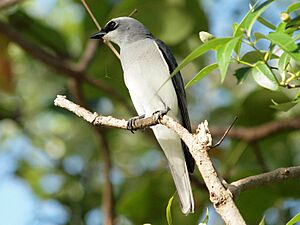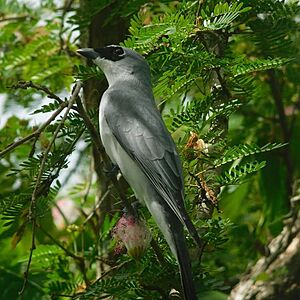White-bellied cuckooshrike facts for kids
Quick facts for kids White-bellied cuckooshrike |
|
|---|---|
 |
|
| In Far North Queensland, Australia | |
| Conservation status | |
| Scientific classification | |
| Genus: |
Coracina
|
| Species: |
papuensis
|
The white-bellied cuckooshrike (Coracina papuensis) is a type of bird that belongs to the Campephagidae family. You can find this bird in places like Australia, the Moluccas, New Guinea, and the Solomon Islands.
Contents
About the White-bellied Cuckooshrike
Naming the Bird
The White-bellied Cuckooshrike was first officially described in 1788. A German scientist named Johann Friedrich Gmelin gave it its scientific name. He included it in his updated book, which was based on the work of Carl Linnaeus.
Gmelin originally placed this bird with crows. He gave it the scientific name Corvus papuensis. Later, in 1816, a French bird expert named Louis Pierre Vieillot created the genus Coracina. The White-bellied Cuckooshrike is now one of 22 species in this group.
What Does It Look Like?
This bird has a short black mask on its face. This mask goes from its beak to its eyes. It also has a thin white ring around its eyes. Its head and upper body are a pale blue-grey color. Its tail feathers are a darker grey.
Even though it's called "white-bellied," its belly can be white or grey. This depends on where the bird lives. Some birds, like the Coracina papuensis robusta subspecies, can be very dark. They might have a lot of black feathers on their neck and chest.
Male and female White-bellied Cuckooshrikes look very similar. Young birds might have light stripes on their undersides. They also look duller than adult birds. Their black face mask is not as clear.
This bird can sometimes be confused with the black-faced cuckooshrike. However, the White-bellied Cuckooshrike is smaller. It also has a more compact body shape. An adult White-bellied Cuckooshrike grows to be about 22 to 29 centimeters long. It usually weighs between 55 and 80 grams.
What Does It Sound Like?
The White-bellied Cuckooshrike has a special call. It sounds like a sharp kissik kissik or quiseek. It also makes a soft, squeaky, slurred sound. This sound repeats as whee-eeyu or wee-year. Some people say it sounds like a parrot.
You can often spot this bird when it flies. It has a unique wavy flight pattern. It flaps its wings to go higher. Then it holds its wings stiffly down to glide.
Where Do They Live?
Distribution and Habitat
The White-bellied Cuckooshrike lives in several countries. These include Australia, Indonesia, Papua New Guinea, and the Solomon Islands. In Australia, you can find it across the tropical northern parts. It also lives in eastern Australia. This includes parts of Western Australia, the Northern Territory, Queensland, New South Wales, and Victoria.
It is very common in Papua New Guinea and the Solomon Islands. It is less common in Indonesia. In Indonesia, it is often found in the northern Moluccas.
This bird can live in many different places. It likes savannas, woodlands, and Eucalyptus forests. It also lives near rivers, in rainforests, and in coastal forests. You might find it in mangroves, open grasslands, or even in gardens. They prefer lower areas and forests, usually below 800 meters above sea level. Most of these birds stay in one area. However, one type, C. p. robusta, can travel long distances.
Behaviour and Life Cycle
Reproduction
White-bellied Cuckooshrikes breed at different times of the year. In Australia, they breed from August to March. In southern New Guinea, they breed from March to June. Both the male and female birds help build the nest.
They usually build their nest on a horizontal tree branch. It is often 7 to 10 meters above the ground. The nest is shaped like a shallow cup. It is made from grass, small twigs, bark, and leaves. They use spider webs to hold it all together. They also decorate it with lichen.
A female bird lays 1 to 3 eggs. The color of the eggs can be different depending on the region. In Papua New Guinea, the eggs are pale blue-green with dark marks. In Australia, the eggs can be pale olive-green, olive-brown, or dull grey. Both parents take care of the eggs. The eggs hatch after about 21 or 22 days. The young birds leave the nest after about 22 days.
Diet
These birds mostly eat large insects. Their diet includes dragonflies, cockroaches, and praying mantises. They also eat grasshoppers, bugs, and beetles. Stick-insects, caterpillars, ants, and wasps are also on their menu. Sometimes, they eat spiders, fruit, and seeds too.
They usually find insects by "gleaning." This means they pick insects off tree leaves. They move through trees from the top branches to the middle. They often forage alone, in pairs, or in small groups. Sometimes, they also catch insects while flying. They might also look for food on the ground.
Conservation Status
The White-bellied Cuckooshrike lives across a very large area. This includes Australia, Papua New Guinea, the Solomon Islands, and the Moluccas. There are many of these birds, and their numbers seem to be growing. Because of this, they are not considered to be in danger. The White-bellied Cuckooshrike is classified as "Least Concern". This means it is not at risk of becoming extinct.



